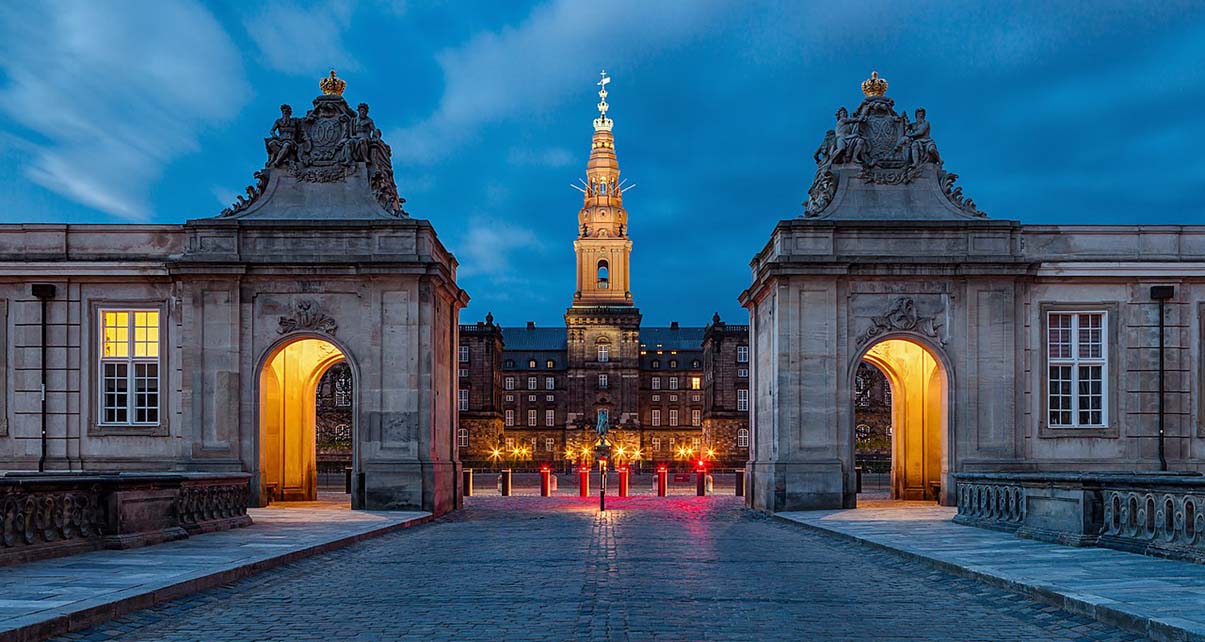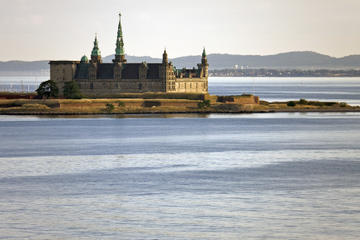
by Susmita Sengupta
The sky was overcast when my husband, daughter and I stepped out of our hotel in Copenhagen, Denmark on an icily cold November morning but the thought of visiting palaces and castles lifted up our spirits. A breakfast of melt in your mouth chocolate croissants in a quaint cafe located on a picturesque street made us feel even better but when we walked out the rain was pouring in sheets. Huddling under umbrellas and frozen to our bones we strode quickly towards our main visit for the day, the Amalienborg Palace.
But before reaching our primary destination, my eyes noticed the elegant green copper dome of a church. The gilded bands on the dome were glistening under the rain filled, cloudy skies. This was the Marble Church, also known as Frederik’s Church, a grand example of Rococo architecture by the Danish architect Nicolai Eigtved. Although its foundation stone was laid by Danish King Frederik V in 1749, the construction stayed incomplete due to financial reasons before it was completed and opened to the public in 1894.
Soon enough, we walked on to an enormous cobblestoned courtyard, more commonly identified as the Amalienborg Palace Square. Bad weather notwithstanding, there were bedraggled tourists, mostly rain soaked like us trying valiantly to quickly click some photos of the giant equestrian statue of King Frederik V, standing guard on the square. The weather could not dim the glory of the four French influenced Rococo palaces that surrounded the palace square which is actually an octagon in shape. The four palaces continue to serve as the winter residence of the Danish royal family. Originally built as homes for four noble families in the 1750s, the royal family converted the palaces into their residences when the Christiansborg Palace was destroyed by fire in 1794.
While Christian IX’s Palace and Frederik VIII’s Palace are closed to the public and serve as homes to members of the present royal family, Christian VII’s Palace is open only through guided tours offered during weekends which can sometimes be canceled due to royal business. We could only make time to see Christian VIII’s Palace which while being the residence of the successor to the throne also houses the museum, “The Royal Danish Collections, Amalienborg”. The ticket booth at the museum was totally bereft of visitors and in a short time we got busy touring the Collection which spread out over two floors. The Antechamber served as an introduction to us about the Danish Royal family about whom I knew next to nothing. In the Garden Room, the large scale model of the palace made in Corian marble caught my attention and it was enlightening to read about the past and present history of the Danish royal family. The palace complex was built by Frederik V to commemorate the 300th anniversary of the crowning of King Christian I who was the first king from the House of Oldenborg. The entire complex was originally designed by Nicolai Eigtved, the royal architect. It was first restored by Nicolai Abildgaard when the royal family moved here in 1794. Today the palaces have been renovated to represent the House of Glucksburg, the royal family that ruled Denmark from 1863-1947.
On the ground floor, the Dining Room had a fabulous display of Royal Copenhagen plates that were a wedding gift to Christian X and Queen Alexandrine in 1898. And the various studies of the kings and the salons of the queens highlighted the Victorian and Renaissance revival décor of heavy furniture, tapestries, draperies, statuettes and busts. The piano nobile or the main floor had the piece de resistance, the Gala Hall, the largest area in the palace with a sumptuously decorated coffered ceiling and a superb crystal Norwegian chandelier all set in a neoclassical style emphasized in a yellow and blue room. But I discovered the Throne Chamber to be quite an austere space with its intense colors of golds and greens and exacting regularity.
Our goal next day was to visit the Rosenborg Castle, a 400-year-old castle built by King Christian IV. Earlier at the Amalienborg Palace, we had learnt about the Changing of Guards ceremony, a tourist magnet in conducive weather to see the Royal Life Guards marching from the barracks at Rosenborg to stand guard at Amalienborg Palace. While it was again pouring cats and dogs outside, we were lucky enough to see the guards dressed in their blue and black fineries and bearskin hats assemble and begin their parade across the city. We turned our attention towards touring the castle interiors. Inside of course, the castle paid tribute to the splendor and spectacle of the royal life and we toured rooms exhibiting magnificent tapestries (the one based on Ovid’s Metamorphoses captured my interest), highly ornamented furniture, richly paneled walls, sometimes with inlaid paintings and absolutely splendid painted ceilings.
So how was this palace and castle any different from other such European palaces? On the second floor was a room identified as “The Glass Cabinet” that was built by Frederik IV in the early 1700s. He was inspired by the porcelain cabinets that he saw on his visit to a palace in Berlin. Although the porcelain cabinet was a fairly common phenomenon in Europe’s palaces, according to the information that I read while touring, the glass cabinet was one of its kind. I stood in a small room with silk covered walls that was packed from its ceiling to its very corners with the Venetian glass collection of the king. There were plates big and small, wine goblets from miniscule to big, pitchers, bowls and carafes all displayed on curvilinear shelves that were edged with gilded festoons. The effect was dazzling.
Our final stop at Rosenborg Castle was a trip down to the basement to view the Treasury and the Danish Crown Jewels. Despite the fact that the regal crowns and jewelry of pearls, emeralds and rubies were spectacular, there were other collections that were truly interesting. The display of 250 little gilt figures of infantry, horsemen and soldiers riding elephants to teach war strategies was one such exhibit. In an exhibit related to astronomy, I learnt about Ole Romer, the Danish astronomer who first measured the speed of light in 1676 and after becoming the king’s favorite advisor in 1681 introduced the concept of standardized weights and measures into the kingdom. When we finished our tour and stepped outside, the rain had stopped and the sandstone embellished red brick Dutch Renaissance style castle with its green spire topped turrets shone against the backdrop of a partly sunny sky like something straight out of a fairy tale.
And so we finished our sightseeing spree by paying a visit to the museum dedicated to Hans Christian Andersen, the author of numerous fairytales and feasibly the most famous Dane who was also a visitor to the royal family at Amalienborg Palace. (The museum shares an entry with Ripley’s Believe it or Not but you can avoid that part and just buy tickets for this if you so desire like we did.) The H. C. Andersen Museum is a little gem that holds a collection of his well-known works and many of his personal belongings like letters, books and photographs. Though everything was in Danish, it was still a pleasure to see his hand written missives, original manuscripts of the fairytale, “The Philosopher’s Stone” and old copies of arguably his most famous fairytale, “The Little Mermaid”. It was thoroughly enjoyable to walk through tableau displays enhanced by colorful light and sound effects of his fairytales like Thumbelina, The Tin Soldier and The Emperor’s New Suit.
Stepping out into the night from the twinkling world of Hans Christian Andersen, the Copenhagen streets resplendent in lavish holiday decorations seemed equally fairytale like and I forgot about the dreary beginning to our morning.
If You Go:
Hans Christian Andersen Museum

Castles Tour from Copenhagen: North Zealand and Hamlet Castle
About the author:
Susmita Sengupta, an architect by background, is a freelance writer who loves to travel. She and her family have traveled to various parts of the USA, Canada, Europe, the Caribbean, Middle East, Southeast Asia and India. She resides in New York City with her family.
Christiansborg Palace photo by Moahim licensed under the Creative Commons Attribution-Share Alike 4.0 International license.


